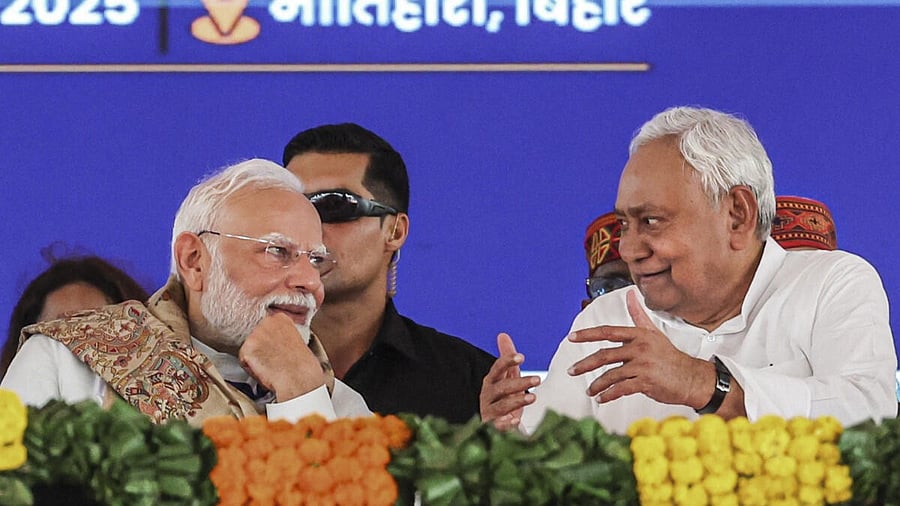
Prime Minister Narendra Modi with Bihar Chief Minister Nitish Kumar
Credit: PTI File Photo
Patna: The National Democratic Alliance (NDA), under the leadership of JD(U) leader and Chief Minister Nitish Kumar, is eyeing another term in Bihar, riding on the planks of 'sushasan' (good governance) and welfare schemes.
The I.N.D.I.A. bloc — comprising the Rashtriya Janata Dal (RJD), the Congress, and other Opposition parties — on the other hand, is aiming to unseat the ruling coalition in the next month’s Bihar Assembly elections.
The Election Commission on Monday announced a two-phase polls in the State, with voting to be held on November 6 and 11 and counting scheduled for November 14.
Political observers say the NDA, with Nitish Kumar as its de facto chief ministerial face, holds many advantages. Nitish Kumar, the longest-serving Chief Minister in Bihar and is one of the most influential political figures in the State, having maintained power for nearly two decades, largely due to a series of welfare schemes like 125 units of free electricity for domestic consumers, supply of potable water in rural areas and the promise of one crore jobs and employment opportunities in the next five years.
Here is a SWOT (strengths, weaknesses, opportunities, threats) analysis of the NDA under Kumar.
Strengths
1. Nitish Kumar, an engineer-turned-politician and the State’s longest-serving Chief Minister, is widely known for his focus on 'sushasan' (good governance).
2. Popular welfare schemes, including enhanced social security pensions, financial aid of Rs 10,000 each to 75 lakh women, and infrastructure development projects.
3. Organised cadre base of JD(U) and BJP, including support from RSS affiliates such as the Akhil Bharatiya Vidyarthi Parishad.
4. Recent launch of development and infrastructure projects in the State by Prime Minister Narendra Modi.
Weaknesses
1. Two decades in power have eroded the freshness of Nitish Kumar's early years (2005-2010).
2. Anti-incumbency could be a factor in the upcoming election.
3. The BJP, despite efforts to expand its social base, is still largely perceived as a party of the upper castes or “forwards”, a term used by Biharis for the upper castes who, according to the survey of castes held a few years ago, account for just over 10 per cent of the population.
Opportunities
1. With Nitish Kumar past his prime and his JD(U) lacking a second-rung leadership worth the name, the BJP can look forward to filling up the vacuum.
Threats
1. Induction of turncoats is seen as a "polluting influence" by those in the BJP. High command culture, once associated with the Congress, is now heard of in the BJP, too, which seems to have got used to power and its trappings.
2. Adherence to 'Hindutva' as an ideology brings its own share of problems. It scares away Muslims, including the Pasmandas, whom Nitish Kumar won over despite being a BJP ally.
(With agency inputs)
